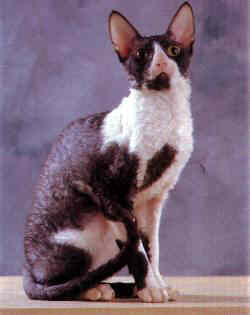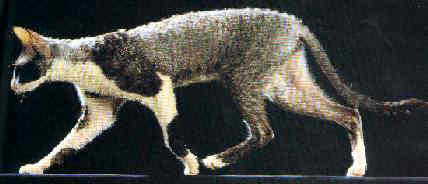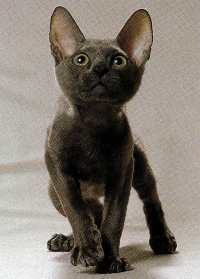CORNISH REX



GENERAL: the Cornish Rex is distinguished from all other breeds by its extremely soft, wavy coat and racy type. It is surprisingly heavy and warm to the touch. All contours of the Cornish Rex are gently curved. By nature, the Cornish Rex is intelligent, alert, and generally likes to be handled.
SUGGESTED BREEDINGS by MENANDPETS.COM
No breeding to signal
if you want to know like signaling yours,
contacts: marketing@inseparabile.it
PROFILE: a curve comprised of two convex arcs. The forehead is rounded, the nose break smooth and mild, and the Roman nose has a high prominent bridge.
HEAD: comparatively small and egg shaped. Length about one-third greater than the width. A definite whisker break, oval with gently curving outline in front and in profile.
MUZZLE: narrowing slightly to a rounded end.
EARS: large and full from the base, erect and alert; set high on the head.
EYES: medium to large in size, oval in shape, and slanting slightly upward. A full eye's width apart. Color should be clear, intense, and appropriate to coat color.
NOSE: Roman. Length is one-third length of head. In profile a straight line from end of nose to chin with considerable depth and squarish effect.
CHEEKS: cheek bones high and prominent, well chiseled.
CHIN: strong, well-developed.
BODY: very distinctive, small to medium in size, males proportionately larger but never coarse. Torso long and slender, not tubular, showing a deep, but not broad chest. The general outline is comprised of graceful arches and curves without any sign of flatness. The back is naturally arched and evident when the cat is standing naturally. The underline gently curves upward from the ribcage to form a smallish (tucked up in appearance) waistline. Hips and thighs muscular and feel somewhat heavy in proportion to the rest of the body.
SHOULDERS: well-knit.
RUMP: rounded, well-muscled.
LEGS: very long and slender. Thighs well-muscled, somewhat heavy in proportion to the rest of the body. The Cornish Rex stands high on its legs.
PAWS: dainty, slightly oval. Toes: five in front and four GO BACK TO LIST.
TAIL: long and slender, tapering toward the end and extremely flexible.
NECK: long and slender.
BONE: fine and delicate.
COAT: short, extremely soft, silky, and completely free of guard hairs. Relatively dense. A tight, uniform marcel wave, lying close to the body and extending from the top of the head across the back, sides, and hips continuing to the tip of the tail. Size and depth of wave may vary. The fur on the underside of the chin and on chest and abdomen is short and noticeably wavy.
CONDITION: firm and muscular.
PENALIZE: sparse coat or bare spots.
DISQUALIFY: kinked or abnormal tail. Incorrect number of toes. Any coarse or guard hairs. Any signs of lameness in the hindquarters. Signs of poor health.
CORNISH REX COLORS
WHITE: pure glistening white. Nose leather and paw pads: pink. Eye color: deep blue or brilliant gold. Odd-eyed whites shall have one blue and one gold eye with equal color depth.
BLACK: dense coal black, sound from roots to tip of fur. Free from any tinge of rust on the tips. Nose leather: black. Paw pads: black or brown. Eye color: gold.
BLUE: blue, lighter shade preferred, one level tone from nose to tip of tail. Sound to the roots. A sound darker shade is more acceptable than an unsound lighter shade. Nose leather and paw pads: blue. Eye color: gold.
RED: deep, rich, clear, brilliant red; without shading, markings, or ticking. Lips and chin the same color as the coat. Nose leather and paw pads: brick red. Eye color: gold.
CREAM: one level shade of buff cream, without markings. Sound to the roots. Lighter shades preferred. Nose leather and paw pads: pink. Eye color: gold.
CHINCHILLA SILVER: undercoat pure white. Coat on back, flanks, head, and tail sufficiently tipped with black to give the characteristic sparkling appearance. Legs may be slightly shaded with tipping. Chin, stomach and chest, pure white. Rims of eyes, lips, and nose outlined with black. Nose leather: brick red. Paw pads: black. Eye color: green or blue-green.
SHADED SILVER: undercoat white with a mantle of black tipping shading down from sides, face, and tail from dark on the ridge to white on the chin, chest, stomach, and under the tail. Legs to be the same tone as the face. The general effect to be much darker than a chinchilla. Rims of eyes, lips, and nose outlined with black. Nose leather: brick red. Paw pads: black. Eye color: green or blue-green.
BLACK SMOKE: individual hair shafts white or silver, each deeply tipped with black. In repose, the cat appears black. In motion, the white base of the hairs is readily apparent. Points and mask black with narrow band of white at base of hairs next to skin which may be seen only when fur is parted. Nose leather and paw pads: black. Eye color: gold. s
BLUE SMOKE: individual hair shafts white or silver, each deeply tipped with blue. In repose, the cat appears blue. In motion, the white base of the hairs is readily apparent. Points and mask blue with narrow band of white at base of hairs next to skin which may be seen only when fur is parted. Nose leather and paw pads: blue. Eye color: gold.
RED SMOKE: individual hair shafts white or silver, each deeply tipped with red. In repose, the cat appears red. In motion the white base of the hair is readily apparent. Points and mask red with narrow band of white at base of hairs next to the skin, which may be seen only when fur is parted. Nose leather and paw pads: rose. Eye color: gold.
CREAM SMOKE: individual hair shafts white or silver, each deeply tipped with cream. In repose, the cat appears cream. In motion the white base of the hair is readily apparent. Points mask cream with narrow band of white at base of hairs next to skin, which may be seen only when fur is parted. Nose leather and paw pads: pink. Eye color: gold.
LAVENDER, LAVENDER AND WHITE, LAVENDER SMOKE: frosty grey with pinkish tones. Eye color: gold. Nose leather, paw pads, eye rims: lavender pink.
CHOCOLATE, CHOCOLATE AND WHITE, CHOCOLATE SMOKE: rich, warm chocolate brown, darker color preferred. Paw pads: cinnamon pink. Eye color: gold. Nose leather, eye rims: brown.
CLASSIC TABBY PATTERN: markings dense, clearly defined, and broad. Legs evenly barred with bracelets coming up to meet the body markings. Tail evenly ringed. Several unbroken necklaces on neck and upper chest, the more the better. Frown marks on forehead form an intricate letter "M." Unbroken line runs back from outer corner of eye. Swirls on cheeks. Vertical lines over back of head extend to shoulder markings which are in the shape of a butterfly with both upper and lower wings distinctly outlined and marked with dots inside outline. Back markings consist of a vertical line down the spine from butterfly to tail with a vertical stripe paralleling it on each side, the three stripes well separated by stripes of the ground color. Large solid blotch on each side to be encircled by one or more unbroken rings. Side markings should be the same on both sides. Double vertical rows of buttons on chest and stomach.
MACKEREL TABBY PATTERN: markings dense, clearly defined, and all narrow pencillings. Legs evenly barred with narrow bracelets coming up to meet the body markings. Tail barred. Necklaces on neck and chest distinct, like so many chains. Head barred with an "M" on the forehead. Unbroken lines running back from the eyes. Lines running down the head to meet the shoulders. Spine lines run together to form a narrow saddle. Narrow pencillings run around body.
SPOTTED TABBY PATTERNmarkings on the body to be spotted. The spots can be round, oblong, or rosette-shaped. Any of these are of equal merit but the spots, however shaped or placed, shall be distinct. Spots should not run together in a broken mackerel pattern. A dorsal stripe runs the length of the body to the tip of the tail. The stripe is ideally composed of spots. The markings on the face and forehead shall be typical tabby markings. Underside of the body to have "vest buttons." Legs and tail are barred.
PATCHED TABBY (classic, mackerel, spotted): an established silver, brown, or blue tabby with patches of red and/or cream. Eye color: gold.
PATCHED TABBY & WHITE(classic, mackerel, spotted): white with colored portions, the colored portions to conform to the currently established patched tabby color standards. Eye color: gold, blue, or odd-eyed.
BROWN PATCHED TABBY: ground color brilliant coppery brown with classic or mackerel tabby markings of dense black with patches of red and/or cream clearly defined on both the body and extremities; a blaze of red and/or cream on the face is desirable. Lips and chin the same shade as the rings around the eyes. Eye color: brilliant gold.
BLUE PATCHED TABBY: ground color, including lips and chin, pale bluish ivory with classic or mackerel tabby markings of very deep blue affording a good contrast with ground color. Patches of cream clearly defined on both body and extremities; a blaze of cream on the face is desirable. Warm fawn overtones or patina over the whole. Eye color: brilliant gold.
SILVER PATCHED TABBY: ground color, including lips and chin, pale silver with classic or mackerel tabby markings of dense black with patches of red and/or cream clearly defined on both body and extremities. A blaze of red and/or cream on the face is desirable. Eye color: brilliant gold or hazel.
SILVER TABBY (classic, mackerel, spotted): ground color, including lips and chin, pale clear silver. Markings dense black. Nose leather: brick red. Paw pads: black. Eye color: green or hazel.
RED TABBY (classic, mackerel, spotted): ground color red. Markings deep, rich red. Lips and chin red. Nose leather and paw pads: brick red. Eye color: gold.
BROWN TABBY (classic, mackerel, spotted): ground color brilliant coppery brown. Markings dense black. Lips and chin the same shade as the rings around the eyes. Back of leg black from paw to heel. Nose leather: brick red. Paw pads: black or brown. Eye color: gold.
BLUE TABBY (classic, mackerel, spotted): ground color, including lips and chin, pale bluish ivory. Markings a very deep blue affording a good contrast with ground color. Warm fawn overtones or patina over the whole. Nose leather: old rose. Paw pads: rose. Eye color: gold.
CREAM TABBY (classic, mackerel, spotted): ground color, including lips and chin, very pale cream. Markings buff or cream sufficiently darker than the ground color to afford good contrast but remaining within the dilute color range. Nose leather and paw pads: pink. Eye color: gold.
TORTOISESHELL: black with patches of red or softly intermingled areas of red on both body and extremities. Presence of several shades of red acceptable. Blaze of red on face is preferred. Nose leather and paw pads: black and/or brick red. Eye color: gold.
TORTOISESHELL SMOKE: individual hair shafts white or silver, each deeply tipped with red or black. In repose, cat appears tortoiseshell. When the coat is parted, the white base of the hairs is readily apparent. Points of the cat may exhibit deeper tipping than in the rest of the coat. Nose leather and paw pads: black and/or brick red. Eye color: gold.
CALICO: white with unbrindled patches of black and red. White predominant on underparts. Eye color: gold, odd-eyed or blue.
CALICO SMOKE: white with unbrindled patches of black and red. In non-white areas, individual hair shafts are white or silver, each deeply tipped with red or black. Cat in repose appears calico. When the coat is parted, the white base of the hairs is readily apparent. Points of the cat may exhibit deeper tipping than in the rest of the coat. Eye color: blue, gold, or odd-eyed.
VAN CALICO: white cat with unbrindled patches of black and red confined to the extremities; head, tail and legs. One or two small colored patches on body allowable. Eye color: gold, blue or odd-eyed.
DILUTE CALICO: white with unbrindled patches of blue and cream. White predominant on underparts. Eye color: gold, blue or odd-eyed.
TORTOISESHELL AND WHITE: black with patches of red softly intermingled (brindled) and white on both body and extremities. Presence of several shades of red acceptable. Less than 1/4 of body being white. Eye color: gold, blue or odd-eyed.
BLUE-CREAM AND WHITE: blue with patches of cream softly intermingled (brindled) and white on both body and extremities. Less than 1/4 of body being white. Eye color: gold, blue or odd-eyed.
BLUE-CREAM: blue with patches of solid cream. Patches clearly defined and well broken on both body and extremities. Eye color: gold.
BLUE-CREAM SMOKE: individual hair shafts white or silver, each deeply tipped with blue or cream. Patches clearly defined and well broken on both body and extremities. In repose, the cat appears blue-cream. In motion, the white base of the hairs is readily apparent. Points and mask blue or cream with narrow band of white at the base of hairs next to skin, which may be seen only when fur is parted. Eye color: gold.
DILUTE VAN CALICO: white cat with unbrindled patches of blue and cream confined to the extremities; head, tail, and legs. One or two small colored patches on body allowable. Eye color: gold, blue or odd-eyed.
BI-COLOR: solid color (black, blue, red and cream) and white; tabby (brown, blue, silver, red and cream) and white; smoke (black, blue, red and cream) and white; and any pointed and white. Cats with no more white than a locket and/or button do not qualify for this color class. Such cats shall be judged in the color class of their basic color with no penalty for such locket and/or button. Eye color: gold, odd-eyed or blue.
VAN BI-COLOR: solid color (black, blue, red and cream) and white; tabby (brown, blue, silver, red and cream) and white; smoke (black, blue, red and cream) and white; and any pointed and white. White cat with color confined to the extremities; head, tail and legs. One or two small colored patches on body allowable. Eye color: gold, odd-eyed or blue.
POINTED: body color can range from white, bluish white, ivory to pale fawn depending on the point color the cat is. The points on the legs, tail, ears and head will be much darker than the body color. Nose leather and paw pads: same color as points. Eye color: blue.
POINTED AND WHITE: a bi-color cat with point color on the head, ears and tail with spots of point color on body and legs along with white. Eye color: blue.
ORC: (Other Rex Colors): any other color or pattern. Eye color: appropriate to the predominant color of the cat. Eye color (where any other color or pattern is coupled with white, exclusive of buttons or lockets): gold, blue or odd-eyed.
above the CFA Breed Standards
after automatic translate from inseparabile.com
History
The
cornish rex July 1950 is born the 21. Mrs. Nina Ennismore, owner of
Councils and cures
Cornish a healthy and sturdy animal much assets, animated from an inexhaustible energy a cat easy to manage its hair does not have need of particular cures, perch in order to maintain it in order enough to smooth down it with one inumidita skin fallow deer in order to remove the dead hairs and to value the natural riccioli. The absence of hair strongly provokes one heat dispersion, for which easy to find the cornish perched on the heater or under blankets This devout cat it has high the inner temperature and in order to satisfy the greater ones necessit, metabolic always eats in continuation (and to the search of a warm Place in which sleeping) voice from high the devout tones regarding the devon Has one, particularly insistent during the period of the heat. The cornish spiritoso and amusing, a cat "clown" as they use to define it its fan. It loves living with people, has need of the physical contact with its landladies on which it depends totally. And at all aggressive brioso and giocherellone and, for this particularly adapted the children.
|
OFFICIAL STANDARD CORNISH REX |
| General aspect | medium ransom |
| Head | short cuneiform and, the bombata forehead incurva towards a flat skull zigomi prominenti and full cheeks. The nose, much short, from the impression of a stop to the short root, mento strongly and moustaches, nearly breaks to you |
| vibrisse goffered, rather hard than medium length | |
| Orecchie | much large, placed low to shape of cone, wide to the rounded off base with estremit'. Very covered of fine hair, with or without hair forelocks that exit from a fold it mails GO BACK TO LIST the orecchie that forms nearly a proteggi-orecchie |
| Eyes | great and ovals, very distance, oblique towards the external of the ear color and clearly pure edge in harmony to the color of the cape |
| Neck | along and thin |
| Body | of medium-long structure, snello but and strongly muscoloso with wide chest long and thin legs, those posterior ones are clearly piu' high of the front ones that the impression gives leggermente be arch small feet and ovals |
| Tail | long, thin and streamlined, very covered of fine down |
| Cape | much short and aim, waved cake and, with or without setole for the varieta' of color reference is made the following tables |
| Defects | a complete cape is preferred but sure the Devon Rex does not have that one down on the ventre. E' a defect the head long and too much tightened of orientaleggiante type or wide type british. The orecchie small, and too much high collected body and lacking muscular tone. Short tail and knot, smooth cape, ispido, zones glabre are a defect in the puppys, piu' serious in the adults |